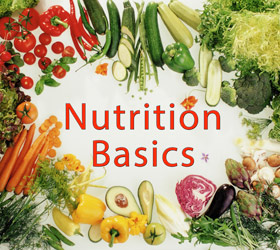Nutrition, Supplements
NUTRITION BASICS
Nutrients can be divided into 2 categories: macronutrients, and micronutrients. Macronutrients are those nutrients that the body needs in large amounts. These provide the body with energy (calories). Micronutrients are those nutrients that the body needs in smaller amounts. below I discover the functions, recommended dietary intake, and food sources of the different nutrients our bodies need.
To calculate your individual needs for each nutrient, check out this helpful tool from the check out this helpful tool
MACRONUTRIENTS
MICRONUTRIENTS
Water Soluble Vitamins
Water
Carbohydrates
Role in the Body
- Fuel during high intensity exercise
- Spares protein (to preserve muscle mass during exercisee)
- Fuel for the Central Nervous System (your brain!)
Recommended Allowance
- Sedentary Individuals: 40-50% of your total daily calories should be carbohydrates
- Exercises Regularly: 60% of your total daily calories should be carbohydrates
- Athletes or persons involved in heavy training: 70% of your total daily calories should be carbohydrates (3.5-4.5 grams of carbohydrate per pound of body weight)
NOTE: 1 gram of carbohydrate = 4 Calories
Food Sources
- Grains (choose mostly whole grains for added benefits)
- Dairy (choose low-fat or non-fat most often)
- Fruit (choose whole fruits more often than fruit juices)
Proteins
Role in the Body
- Tissue structure (part of organ tissues, muscle, hair, skin, nails, bones, tendons, ligaments and blood plasma)
- Part of cell plasma membranes
- Involved in metabolic, transport, and hormone systems
- Make up enzymes that regulate metabolism
- Invovled in acid/base balance to maintain a neutral environment in our bodies
Recommended Daily Allowance
- Sedentary Individuals: 0.36 grams of protein per pound of body weight
- Recreationally Active: 0.45-0.68 grams of protein per pound of body weight
- Competitive Athlete: 0.54-0.82 grams of protein per pound of body weight
- Teenage Athlete: 0.82-0.91 grams of protein per pound of body weight
- Body Builder: 0.64-0.91 grams of protein per pound of body weight
- When restricting Calories: 0364-0.91 grams of protein per pound of body weight
- Maximum amount of protein the body can utilize: 0.91 grams of protein per pound of body weight
NOTE: 1 gram of protein = 4 Calories
Food Sources
- Legumes (beans)
- Lentils
- Soy products, such as tofu
- Peanuts and nuts
- Whole grains (quinoa, oats, brown rice)
- Seeds
- Meat alternative products
- Some vegetables
- Animal sources
Fats
Role in the Body
- Energy reserve
- Protects vital organs
- Insulation
- Transport fat soluble vitamins
Recommended Allowance
- 20-35% of your total daily calories should come from fat
Less than 10% of total daily calories should come from Saturated Fat (coconut and plam kernal oil, shortening, butter, cream cheese, full fat dairy products)
NOTE: 1 gram of fat = 9 Calories
Food Sources
- Oils
- Nuts
- Seeds
- Meat, fish, dairy
- Micronutrients
Vitamin B1: Thiamin
Function
- Needed to release energy in food
- Prevents beriberi
Food Sources
- Whole grains
- Dried beans
- Peas
- Peanuts
- Animal proteins
Vitamin B2: Riboflavin
Function
- Needed to build and maintain body tissues
Food Sources
- Whole grains
- Green and yellow vegetables
- Animal proteins
Vitamin B6: Pyridoxine
Function
- Helps the development of the nervous system
- Involved in the production of blood
- Helps break down protein and glucose to produce energy for the body
Food Sources
- Potatoes
- Chickpeas
- Yeast
- Nuts
- Bulgur
- Fish
- Rice
- Bananas
Vitamin B12: Cobalamine
Function
- Promotes proper growth and development of the nervous system
Food Sources
- Fortified cereals
- Nutritional yeast
- Algae
- Animal products
Vitamin C: Ascorbic Acid
Function
- Helps form growth hormones
- Needed to build strong gums, teeth, and bones
- Antioxidant
Food Source
- Citrus fruits
- Cabbage
- Berries
- Peppers
Folic Acid
Function
- Helps build DNA and protein
- Helps maintain intestinal tract
- Aids in bone growth
- Prevents nervous system birth defects
Food Sources
- Dark green leafy vegetables
- Yeast
- Wheat germ
Vitamin A: Retinal
Function
- Vision
- Healthy skin
- Healthy hair
Food Sources
- Animal products
- Body can make vitamin A from vegetables that have carotene
- Carrots
- Sweet potatoes
- Other red-orange vegetables
Vitamin D
Function
- Promotes strong teeth and bones
- Prevents rickets
Food Sources
- Mushrooms
- Dairy Milk & Fortified Non-Dairy Milk
- Fortified cereals
- Cod liver oil
- Tuna
- Salmon
- Egg yolks
- Produced by the body when exposed to sunlight
Vitamin E
Function
- Prevents damage to cell membranes
- Protects vitamin A
- Aids in blood production
Food Sources
- Seeds and Nuts
- Vegetable oil
Vitamin K
Function
- Aids in blood clotting
Food Sources
- Green leafy vegetables
- Produced by bacteria in the large intestine
Calcium
Function
- Maintains teeth and bones
- Helps blood clot
- Helps nerves and muscles function
Food Sources
- Dairy Milk & Fortified Non-Dairy Milks
- Dark green vegetables
- Sardines
- Clams
- Oysters
- Legumes
- Almonds
Potassium
Function
- Regulates water balance in cells
- Helps nerves function
- Important for heart rhythm
Food Sources
- Oranges
- Bananas
- Cereal
- Potatoes
- Dried beans
Sodium
Function
- Regulates water balance
- Stimulates nerves
Food Sources
- Table salt
- Bread
- Almost everything
Iron
Function
- Forms blood cells
- Transports oxygen throughout the body
Food SourceS
- Dark green vegetables
- Whole-grain cereals
- Whole grains, such as brown rice & quinoa
- Legumes
- Lentils
- Nuts
- Seeds
- Dried fruits
- Animal proteins
Zinc
Function
- Aids in transport of carbon dioxide
- Aids in healing wounds
- Forms enzymes
Food Sources
- Whole grains
- Dairy Milk & Fortified Non-Dairy Milks
- Legumes
Water
Functions
- Moistens tissues such as those in the mouth, eyes, and nose
- Protects body organs and tissues
- Helps prevent constipation
- Helps dissolve minerals and other nutrients to make them accessible to the body
- Regulates body temperature
- Lubricates joints
- Lessens the burden on the kidneys and liver by flushing out waste products
- Carries nutrients and oxygen to cells

